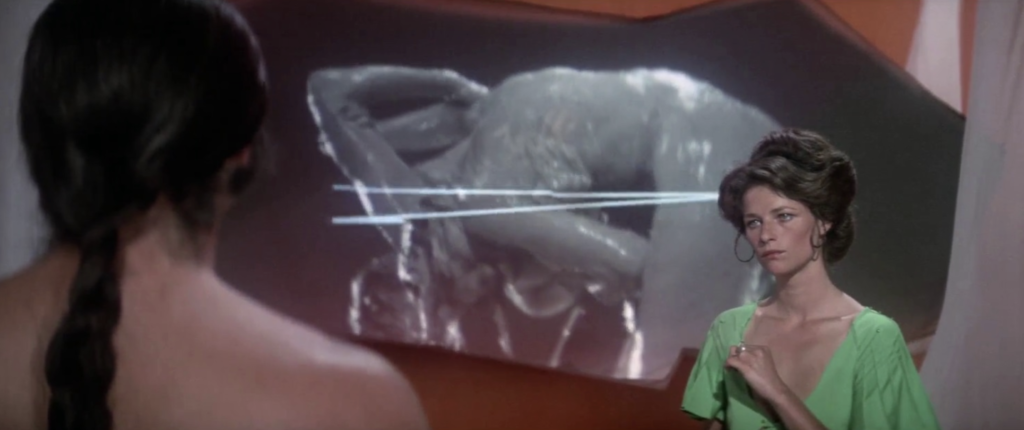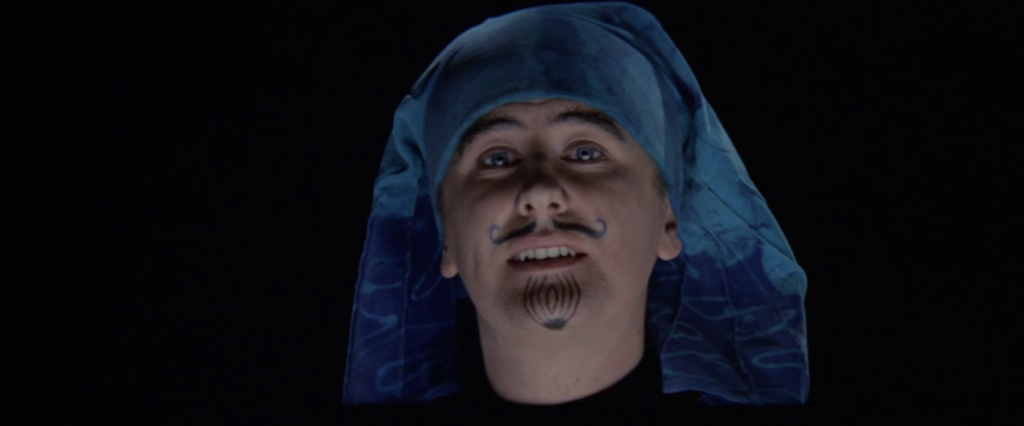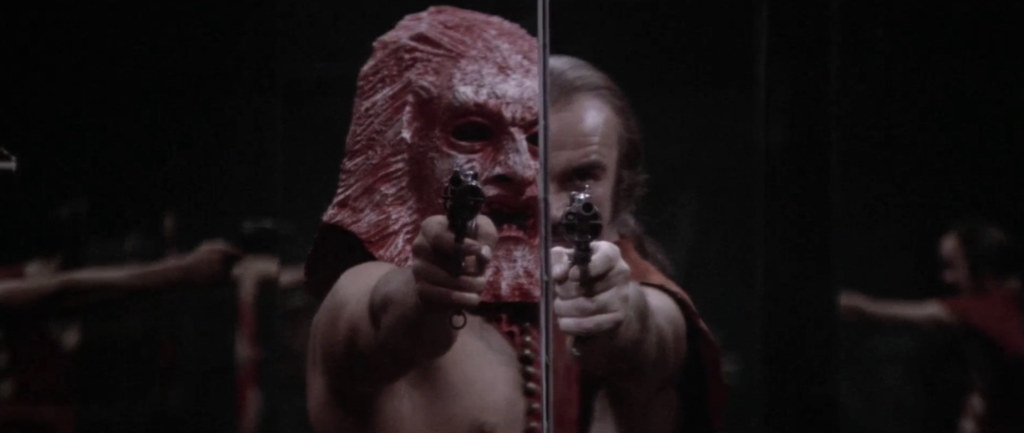| Michael Popham |

Zardoz plays at the Trylon Cinema from May 12th through May 14th. Visit trylon.org for tickets and more information.
When people see the movie Zardoz for the first time, they usually walk out of the theater with a lot of questions. Chief among them is, “What the fuck was that all about?”
I’ll admit this isn’t a movie for everyone. But hear me out: Zardoz is not just a perfect example of 1970s sci-fi (of the antediluvian pre-Star Wars era, of course) but it’s also a courageous film that simply couldn’t have happened in any other time or place. It’s deeply flawed and ostentatiously weird, but it is also more than the sum of its (quite eccentric) parts.
Most sci fi movies of the time were low-budget indie productions, aimed at college-age audiences and not expected to make massive profits. Because the budgets were low, the studios didn’t tend to give them a lot of oversight, so filmmakers got away with a lot.
Zardoz also got away with a lot because it was released in 1974, the absolute nadir of 20th-century pessimism—a pessimism that had been brewing for a long time. When journalist Lincoln Steffens first visited the newly-created Soviet Union in 1919, he summarized his impressions with a single, famous declaration: “I have seen the future, and it works.” The promise of a utopian society in which everyone labored as equals toward the common good intoxicated idealists like Steffens. Here was a society that, for the first time in history, was designed to eliminate greed, corruption, and misery.
It didn’t take long for him to realize that his assessment was premature. Greed, corruption, and misery might have been banned by law, but they did quite well in the young Soviet state. Purges, pogroms, and famines wiped out the optimism of the Soviet Union’s early enthusiasts (and quite a few of the early enthusiasts themselves), and soured an entire generation on utopianism altogether.

That wasn’t the end of it. The 20th century turned out to be jam-packed with disappointments of all kinds: a global depression, a Second World War, the Holocaust, civil unrest, ecological havoc, overpopulation, the threat of nuclear annihilation, and a decades-long cold war. By the 1970s, disillusionment wasn’t just for globe-trotting news correspondents or intellectuals who’d read too much Sartre. Now disillusionment was for everybody.
Even the sunniest of optimists seemed a bit deflated; they sensed that the future was falling apart. Those anxieties were carried over into the sci-fi films of the era, all filled with cynicism and despair: in Silent Running (1971), the world’s last remaining forest is at first transplanted onto a spacecraft when there’s no more room for it on Earth, and then ordered destroyed; in Z.P.G. (1972) a ghastly overpopulated future society declares that no one can give birth to a child for 20 years; in Soylent Green (1973), an evil corporation feeds a starving world nutritious green crackers that are, it is later revealed, made from human flesh. And right in the midst of all these downers, in the trailer for Zardoz (1974) we’re treated to Steffens’s famous declaration, now updated to fit the zeitgeist of the Sad 70s: I have seen the future, and it doesn’t work.
Zardoz was the brainchild of John Boorman, who had scored a big hit with Deliverance (1972). The studio offered him a chance to go ahead and make whatever kind of follow-up he wanted. Few directors have taken advantage of that offer the way Boorman did.
The movie begins with a baffling introduction from one Arthur Frayn (Niall Buggy), whose status as an unreliable narrator is emphasized with a drawn-on beard and mustache. He describes himself as both magician and a charlatan, and the creator of Zardoz.1
Then we’re taken to what looks like the Irish countryside, where downtrodden peasants till the soil (this is, we’re informed via a title card, the year 2293). Gangs of Exterminators—mustachioed barbarians wearing red diapers—travel the countryside on horseback, wiping out the hapless country folk. After a good deal of antisocial behavior, the Exterminators clamor around the giant stone head of Zardoz, their god, and Zardoz shouts to them that the penis is evil and the gun is good, then disgorges lots of firearms and tells them to keep up the good work. Its task as NRA spokesman complete, Zardoz then ascends to the heavens (accompanied by the adagio from Beethoven’s 7th symphony) and floats away to wherever it comes from.

But one of the Exterminators, Zed (Sean Connery) has secretly slipped inside the head of Zardoz and takes flight with it, arriving at a bucolic enclave known as the Vortex. This is the home of the Eternals, who are forever beautiful and young, and who wear extremely 1970s garments. It is, for all intents and purposes, an upscale hippie commune, led by Consuella (Charlotte Rampling). They regard Zed as something less than human, but they still find him intriguing.
It soon becomes clear that the Eternals have a serious problem: they’re bored with their empty lives and, though they won’t admit it, are disillusioned with immortality. Zed’s arrival provides them with some much-needed diversion, but it’s clear they’re in need of a much more radical solution. They know that Zed has come to the Vortex on some mission, and that it has something to do with the mysterious Arthur Frayn. But what?
While there’s a lot of pseudo-intellectual banter in the script, little of it is thematically innovative. The notion that living a life of luxury without responsibility is bad, or that eternal life would be a curse, or that religious fanaticism is a dead end, are not profound or original ideas, but Boorman presents them eagerly as though they are; and as a would-be utopian society the Vortex seems far less like a place you’d care to visit than the never-ending theme park of hot young people depicted in Logan’s Run (1976).
Perhaps the one truly interesting idea rattling around in Zardoz is the notion that God is neither a loving creator of the universe, nor a cynical racket run by shady opportunists, but more of a schoolboy prank that got out of hand long ago.
Is this a good movie? I don’t think it is. But it might be a great movie. It is by turns captivating, overblown, sophomoric, dreamlike, silly, pretentious and, at times, oddly brilliant. It’s a movie that takes enormous chances and isn’t afraid to look ridiculous or to blow itself to smithereens—which it does over and over again over the course of the film’s running time.
It’s a movie I can’t say that I like, exactly, but it’s one that I’ve always admired—not only for its ambition, but for its indifference to what any studio head, test audience, focus group, or even ticket-buyer might think of it. Five decades after its release it’s still the ultimate low-budget, drug-fueled, would-be-intellectual sci-fi semi-masterpiece. And that’s something.
References
1 The studio, believing audiences would be flummoxed by the movie’s first act, insisted on an introduction that would explain the backstory. Instead, they got the floating head of a weirdo in a medieval hat, who spouts as much nonsense as everyone else in the picture does.
Edited by Olga Tchepikova-Treon
